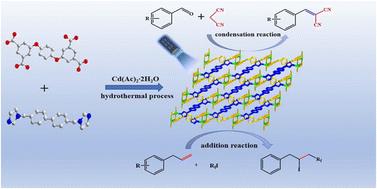双使能光响应镉-有机骨架的Knoevenagel缩合和烯烃全氟烷基化反应
IF 9.2
1区 化学
Q1 CHEMISTRY, MULTIDISCIPLINARY
引用次数: 0
摘要
本文以醋酸镉(Cd(Ac)2·2H2O)、1,4-二(3,5-二羧基苯氧基)苯(H4DDB)和4,4-双(咪唑-1-甲基)联苯(4,4 ' -bimp)为原料,采用水热法合成了三维多孔镉有机骨架[Cd(DDB)0.5(4,4 ' -bimp)0.5(H2O)]·H2O (Cd- mof)。Cd-MOF的无色片状晶体是基于DDB与双核Cd2单元连接的二维网络的4,4 ' -双柱框架。这种非贵金属材料具有较宽的光吸收、优异的热稳定性、高循环可回收性和介孔比表面积。在蓝色LED (450nm)光源激发下,实现了Cd-MOF的双光催化活性:光催化醛类与丙二腈的Knoevenagel缩合反应(产率达67-97.6%)和高效光驱动烯烃-全氟烷基碘化物原子转移自由基加成反应(产率达51-94.8%),实现了“一石二鸟”的效果。控制实验和理论计算支持我们提出的自由基机理。这些反应具有底物适用性广、官能团耐受性好、反应条件温和等特点。这项工作拓宽了mof基材料在光催化领域的应用,为未来可持续的绿色有机合成提供了新的思路。本文章由计算机程序翻译,如有差异,请以英文原文为准。

Dual enabling photomediated Knoevenagel condensation and alkene perfluoroalkylation reactions by a photoresponsive cadmium–organic framework†
In this paper, a 3D porous cadmium–organic framework, named [Cd(DDB)0.5(4,4′-bimp)0.5(H2O)]·H2O (Cd-MOF), was synthesized by hydrothermal synthesis using cadmium acetate (Cd(Ac)2·2H2O), 1,4-di(3,5-dicarboxyphenoxy)benzene (H4DDB) and 4,4-bis (imidazole-1-ylmethyl)biphenyl (4,4′-bimp) as raw materials. The colorless flake-like crystal of Cd-MOF is a 4,4′-bimp-pillared framework based on a 2D network from DDB linked with the dinuclear Cd2 unit. This non-precious metal material exhibits relatively wide light absorption, excellent thermal stability, high cycle recyclability, and a mesoporous specific surface area. Under the excitation of a blue LED (450 nm) light source, the dual photocatalytic activity of the Cd-MOF was realized: the photocatalytic Knoevenagel condensation reaction of aldehydes and malononitrile (yield up to 67–97.6%) and an efficient light-driven olefin-perfluoroalkyl iodide atom transfer radical addition reaction (yield reached 51–94.8%), achieving a “two birds with one stone” effect. Control experiments and theoretical calculations support our proposed radical mechanism. These reactions feature broad substrate applicability, good functional group tolerance and mild conditions. This work broadens the application of MOF-based materials in the field of photocatalysis and provides new ideas for sustainable green organic synthesis in the future.
求助全文
通过发布文献求助,成功后即可免费获取论文全文。
去求助
来源期刊

Green Chemistry
化学-化学综合
CiteScore
16.10
自引率
7.10%
发文量
677
审稿时长
1.4 months
期刊介绍:
Green Chemistry is a journal that provides a unique forum for the publication of innovative research on the development of alternative green and sustainable technologies. The scope of Green Chemistry is based on the definition proposed by Anastas and Warner (Green Chemistry: Theory and Practice, P T Anastas and J C Warner, Oxford University Press, Oxford, 1998), which defines green chemistry as the utilisation of a set of principles that reduces or eliminates the use or generation of hazardous substances in the design, manufacture and application of chemical products. Green Chemistry aims to reduce the environmental impact of the chemical enterprise by developing a technology base that is inherently non-toxic to living things and the environment. The journal welcomes submissions on all aspects of research relating to this endeavor and publishes original and significant cutting-edge research that is likely to be of wide general appeal. For a work to be published, it must present a significant advance in green chemistry, including a comparison with existing methods and a demonstration of advantages over those methods.
 求助内容:
求助内容: 应助结果提醒方式:
应助结果提醒方式:


